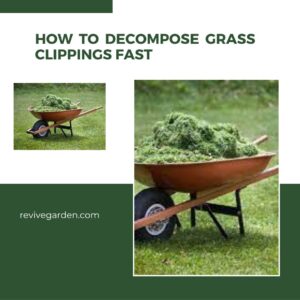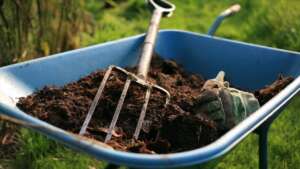Table of Contents
 If you want to get rid of grass clippings quickly and efficiently, you’ve come to the right place. To get rid of grass clippings fast, many people bag them as garbage. By this, you have wasted valuable natural resources as well as you are caused by environmental pollution.
If you want to get rid of grass clippings quickly and efficiently, you’ve come to the right place. To get rid of grass clippings fast, many people bag them as garbage. By this, you have wasted valuable natural resources as well as you are caused by environmental pollution.
In this article, we’ll teach you a tried and true method for fast-decomposing grass clippings, which will reduce waste and improve the environment. By following these steps, you’ll be able to learn how to decompose grass clippings fast in a matter of days rather than weeks or months. So what are you waiting for? Get started, and let us show you how to decompose grass clippings fast!
Step-by-Step Guide to Rapidly Decompose Grass Clippings
By following this comprehensive step-by-step guide, you can effectively accelerate the decomposition of grass clippings and transform them into nutrient-rich compost. Embracing these practices benefits your lawn and contributes to a healthier and more sustainable garden ecosystem.
Step 1: Proper Clipping Management
1. Bagging vs. Mulching
When managing your grass clippings, mulching proves to be a superior choice. Mulching involves finely chopping the clippings and leaving them on the lawn. This method allows the clippings to break down quickly due to their smaller size, returning valuable nutrients to the soil.
2. Optimal Clipping Length
The length at which you mow your lawn can significantly impact the decomposition process. To expedite decomposition, mow your lawn when the grass is dry, and ensure you never remove more than one-third of the grass’s height. Shorter clippings decompose faster and integrate better into the lawn.
Step 2: Creating Ideal Decomposition Conditions
1. Aeration and Moisture
Promoting airflow and maintaining adequate moisture are key factors in accelerating grass clipping decomposition. Raking or using a dethatcher to break up clumps, followed by spreading the clippings evenly, ensures better air circulation. Keeping the clippings moist, especially during dry periods, also facilitates faster breakdown.
2. Temperature Considerations
Temperature plays a crucial role in decomposition rates. Warmer temperatures facilitate microbial activity, resulting in faster breakdown. Water the clippings when needed to maintain optimal moisture and temperature levels, ensuring an environment conducive to rapid decomposition.
Step 3: Utilizing Natural Enhancers
1. Beneficial Microbes
Introducing beneficial microbes to your grass clippings can significantly speed up decomposition. Consider using a compost starter that contains a variety of beneficial bacteria. These microbes work to break down the clippings more efficiently, converting them into nutrient-rich compost.
2. Grass Clipping Layering
Enhance the decomposition process by layering grass clippings with other organic materials. Mixing clippings with “brown” materials like leaves, shredded paper, or straw helps create a balanced carbon-to-nitrogen ratio—alternate layers of clippings and other materials to promote quicker breakdown.
Step 4: Composting with Grass Clippings
1. Carbon-to-Nitrogen Ratio
Maintaining the right carbon-to-nitrogen ratio is essential for successful composting. Combine your grass clippings with “brown” materials such as dried leaves or shredded paper to achieve a balanced ratio. This balance fuels microbial activity and ensures efficient decomposition.
2. Composting Methods
Utilize a compost bin or designated compost pile to contain the materials. Regularly turning the pile with a pitchfork or compost turner aerates the mixture, aiding decomposition. Mixing fresh grass clippings with older compost materials encourages even breakdown and nutrient distribution.
Step 5: Practical Tips for Faster Decomposition
1. Regular Maintenance
Increase the frequency of your lawn mowing to generate smaller grass clippings. Smaller clippings decompose faster and are less likely to clump together. Additionally, avoid mowing wet grass, as it can lead to clumping and hinder decomposition.
2. Turning and Mixing
Regularly turning and mixing your compost pile is vital for maintaining proper aeration. Every 1-2 weeks, use a pitchfork to turn the pile, ensuring that all materials are thoroughly mixed. This practice prevents the pile from becoming compacted and promotes uniform decomposition.
Step 6: Potential Pitfalls to Avoid
1. Over-application of Clippings
Avoid overloading your compost pile with too many grass clippings at once. Excessive clippings can lead to matting and slow down the decomposition process. Instead, spread the clippings in thin, even layers to encourage faster breakdown.
2. Contamination and Weed Management
Ensure that the grass clippings you use for composting are free from weeds with mature seeds or invasive plants. Additionally, avoid adding clippings treated with pesticides or chemicals, as these can disrupt the natural decomposition.
Benefits

The main benefit of leaving grass clippings on top of the soil is that they act as mulch, which helps retain moisture and prevent weeds from growing. However, if you leave them on top too long, they will start to break down and become a slim mess that will inhibit root growth.
Add Grass Clippings To The Compost Pile Or Bin
If you don’t have enough space for all your grass clippings, consider adding them to a compost pile or bin instead. This will help speed up the decomposition process because it’s an aerobic environment (oxygen-rich).
Use as mulch
Grass Clippings don’t decompose quickly. If you pile them up, they will rot and smell bad. The best way to dispose of grass clippings is by mulching them into the soil with a mower deck attachment.
Mulch Mower
The problem with this method is that it’s hard work. A better option is to use a “mulch mower” that shreds the clippings into very small pieces before depositing them onto the ground. This makes it easier for soil microbes to decompose without causing an odor problem like rotting leaves in compost piles or trash cans.
Animal Feed
Use grass clippings as animal feed. Grass clippings make great animal feed for chickens, goats, and cows. They’re high in protein, making them an excellent source of nutrients for livestock.
Turning Clippings into Compost
You can speed up the decomposition of grass clippings by turning them into compost. This is the best way to recycle your lawn waste and add nutrients to the soil.
The process of making grass-clipping compost is simple, but it does take some time. The process can speed up by shredding the grass clippings before adding them to your compost bin or pile. Shredded clippings will break down faster because they have more surface area exposed to air and moisture than whole clippings.
Ways to Make Compost – Turning Waste into Garden Gold

Composting is a natural process that transforms organic waste materials into a nutrient-rich soil amendment, commonly referred to as “black gold” for gardeners. It’s a sustainable practice that reduces landfill waste and enriches garden soil. Here, we’ll explore different ways to make compost, each catering to various preferences, spaces, and levels of involvement.
Backyard Composting
Traditional Compost Pile: This method involves creating a simple pile or mound of compostable materials in your backyard. Choose a suitable location with good drainage and access to sunlight. Layer green materials (nitrogen-rich) like kitchen scraps and grass clippings with brown materials (carbon-rich) such as leaves, straw, and shredded paper. Turn the pile regularly to aerate and mix the contents, aiding decomposition. Over time, the pile will break down into nutrient-rich compost.
Compost Bins: Compost bins provide a contained space for composting and offer better aesthetics. They come in various sizes and designs, from basic stationary bins to more advanced tumbling or rotating bins. The process is similar to a compost pile, but bins help retain heat, moisture, and control over the composting environment. Turning and mixing are often simplified with tumbling bins, promoting faster breakdown.
Vermicomposting (Worm Composting)
Worm Bins: Vermicomposting involves using specific types of worms (such as red wigglers) to break down organic materials. Worm bins are designed to house these worms and the organic waste they consume. This method is ideal for those with limited outdoor space or who want to compost indoors. The worms’ activities produce nutrient-rich castings (worm poop) that make excellent plant fertilizer.
Composting with Enclosed Systems
Trench Composting: In this method, you dig a trench in your garden and fill it with compostable materials. This trench is an in-ground composter, allowing waste to decompose directly in the soil. Over time, the nutrients from the compost seep into the surrounding soil, enriching it for future plant growth.
Compost Tumblers: Compost tumblers are elevated containers you can rotate to mix and aerate the composting materials. They’re efficient at creating well-mixed compost quickly. The enclosed design helps retain heat and moisture, promoting faster decomposition.
Composting with Specialized Equipment
Bokashi Composting: Bokashi is a Japanese method that involves fermenting organic waste using a special mix of beneficial microorganisms. The fermented waste is not fully decomposed but can be buried in soil or added to a traditional compost pile. Bokashi bins are airtight containers where you layer waste with the microbial mix. This method is quick and suitable for small spaces.
Municipal Composting
Many municipalities offer curbside compost pickup or have composting facilities where you can drop off your organic waste. These facilities use large-scale composting methods to process a wide variety of materials. This option is convenient if you want to avoid composting at home or have limited space.
Tips for Successful Composting
- Maintain a balanced carbon-to-nitrogen ratio for efficient decomposition.
- Chop or shred larger materials to speed up breakdown.
- Keep the compost pile moist but not soggy.
- Regularly turn and mix the compost to provide oxygen to the microbes.
- Avoid adding meat, dairy, oily foods, or pet waste to your compost.
Composting takes time, but the result—a nutrient-rich soil amendment—will greatly benefit your garden, reduce waste, and contribute to a more sustainable lifestyle.
How to Compost Grass Clippings Fast (FAQs)
How Does Compost Accelerator Work?
Compost accelerators (also called humic acids) contain naturally occurring organic compounds that help microorganisms break down organic matter faster than they normally would.
How Do I Use Compost Accelerators?
It’s easy! Just sprinkle the accelerator over your grass clippings before adding them to your compost bin or pile. You can mix it with other materials in the container if you prefer not to sprinkle it on top of everything else.
Can you compost grass clippings?
Yes, you can compost grass clippings! Grass clippings contain many nutrients and can be composted in your backyard compost pile.
What does the grass look like when it is ready to be composted?
Grass that is ready for composting will be mostly brown and dry. If you still see green or other colors in the grass, it is not yet ready for composting.
Does the decomposition of grass clippings take time?
It takes about two months for the grass to decompose in a backyard compost pile.
Conclusion
Grass clippings can decompose quite easily by converting them into compost. This can be a great way to eliminate these clippings and make room in your garden for new growth. Following this article’s steps, you can decompose grass clippings quickly and easily!
